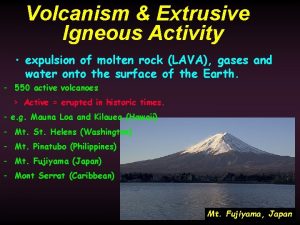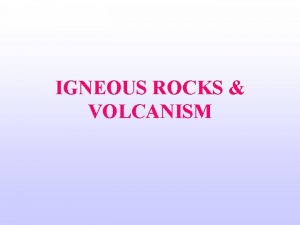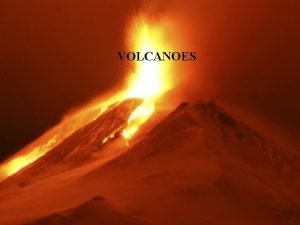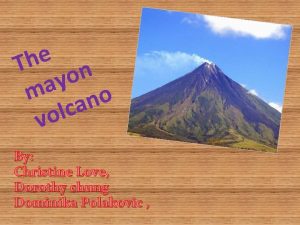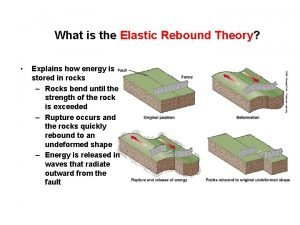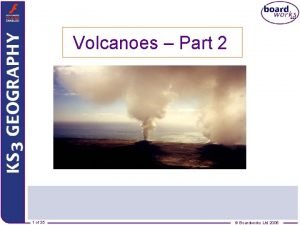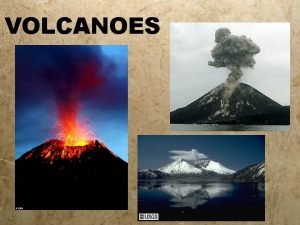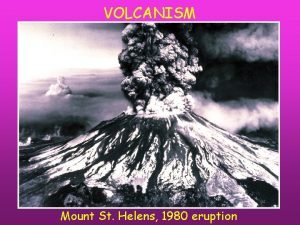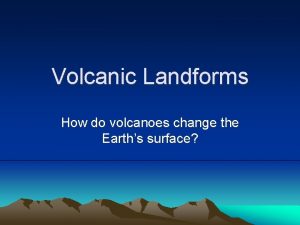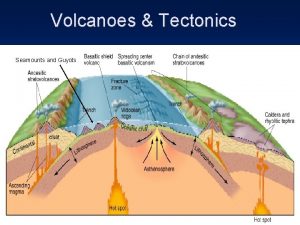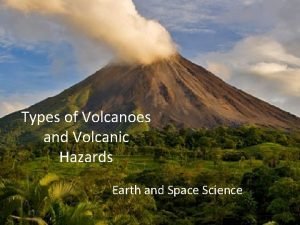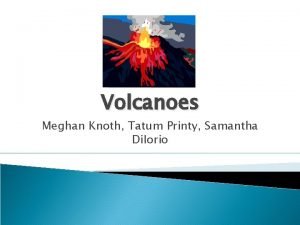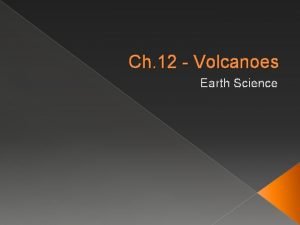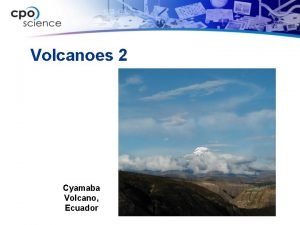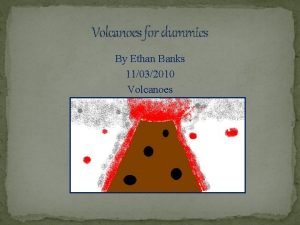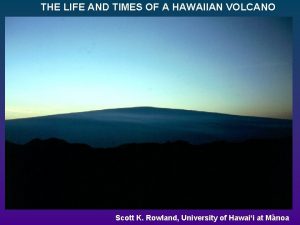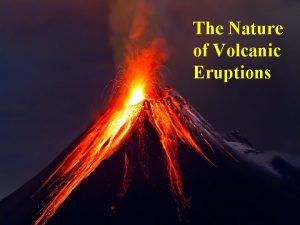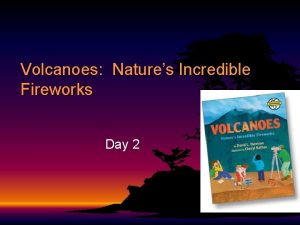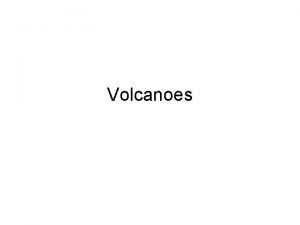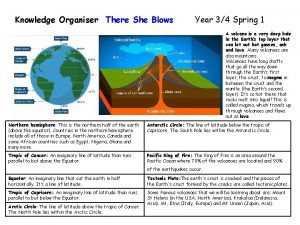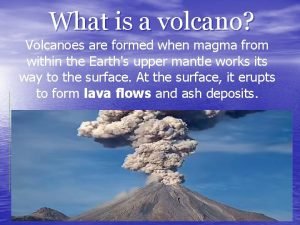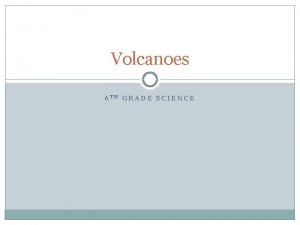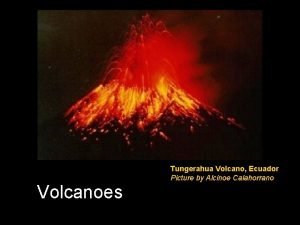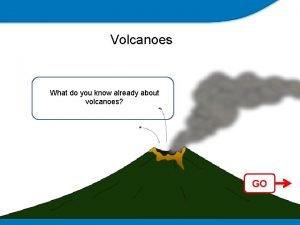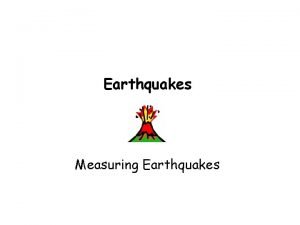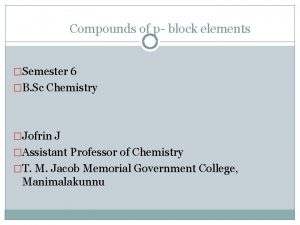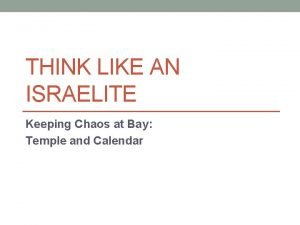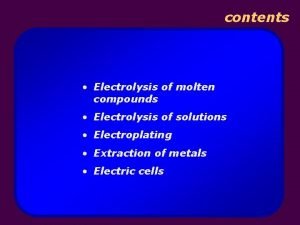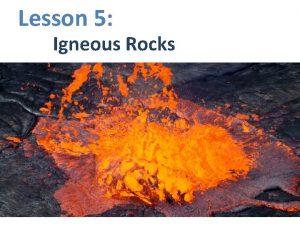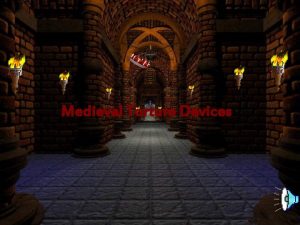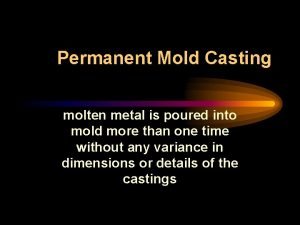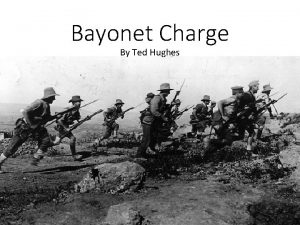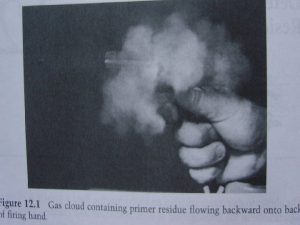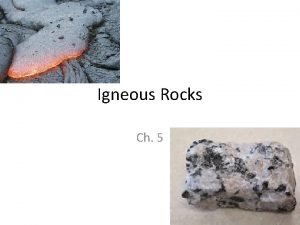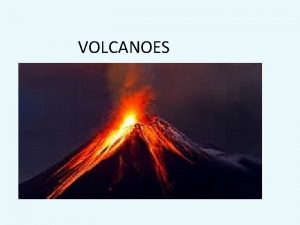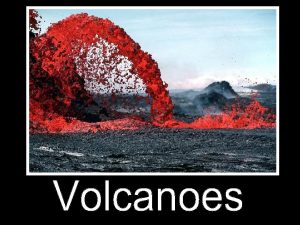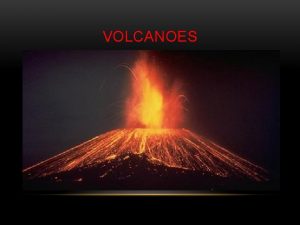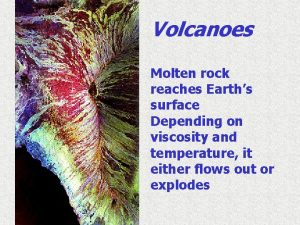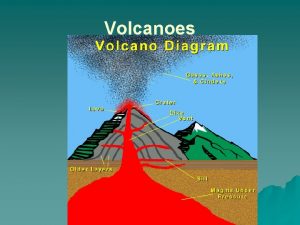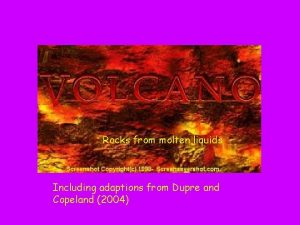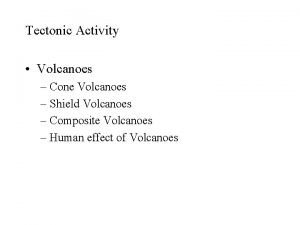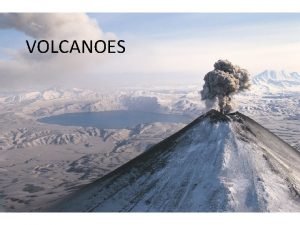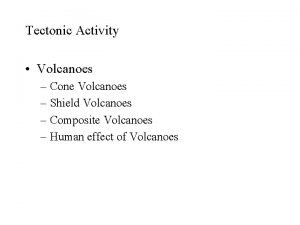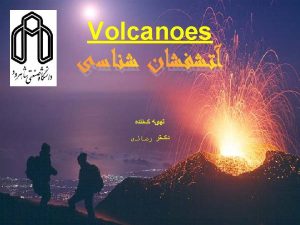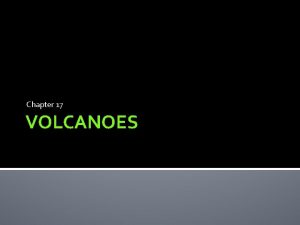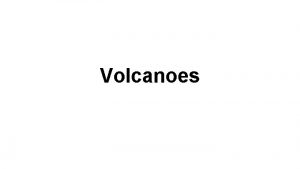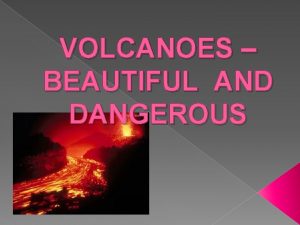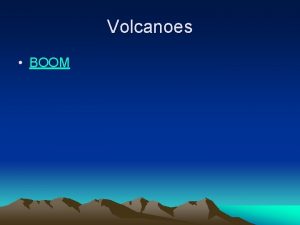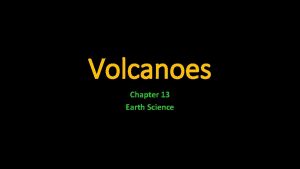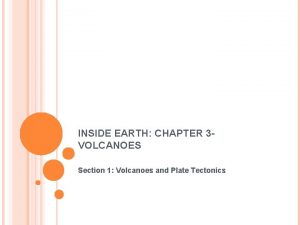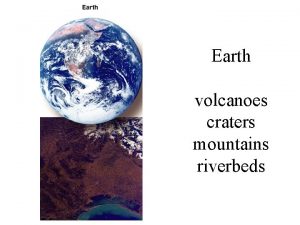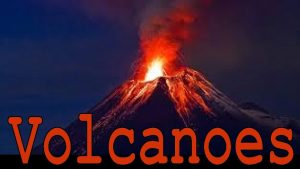Volcanoes Lava Lava Molten rock outside the earth



























































- Slides: 59

Volcanoes

Lava • Lava: Molten rock outside the earth • Magma: Molten rock inside the earth • Types of Lava – Aa • Rough and Stone Like • Looks like angular rocks • Made of liquid lava and pieces of solid, cooled lava – Pahoehoe • Smooth surface • Looks like one continuous flow of lava • Can resemble a rope – Pillow • Formed when lava is cooled in water • Smooth and spherical

Aa

Pahoehoe

Pillow

Volcano Terminology • Tephra – A mix of gas, rock that are emitted from a volcano – Rock can be small (ash) or large (6 inches) • Pyroclastic Flow – Tephra that flows along the ground quickly (450 mi/hr) • Lahars – Mudflows made of dirt, tephra, and water. – Flow down the mountain often in riverbeds. • Caldera – The crater left at the top of a mountain after an eruption.

What Volcanoes Look Like Underground

Vesuvius • Only volcano on the European mainland. • First Eruption was 17, 000 years ago. • Last major eruption was 100’s of years ago. – AD 79 • Composite Volcano • At a convergent Boundary between the Eurasian and African plates.


AD 79 Eruption • Buried the Roman towns of Pompeii and Herculaneum. • 7 years prior to eruption there was a powerful earthquake that disturbed the volcano • Small earthquakes became common leading up to the eruption. • Erupted on August 24 th – a day the Romans honored their god of fire.

AD 79 Eruption • The site has been uncovered and studied • Most bodies were found in homes and thought to have died of roof collapses. • Herculaneum was buried with 75 feet of ashes and rocks. • Neither town was rebuilt after the explosion, but new towns have grown and the mountain is again densely populated.






Pinatubo • Active Volcano – Last major eruption was in 1991 – First eruption was about 45, 000 years ago • • Part of a chain of volcanoes in the Philippines Many small eruptions since 1991 Composite Volcano At a convergent boundary between two small plates.



1991 Eruption • The second largest volcanic eruption of the 20 th century. • Started with small eruptions and hundreds of small earthquakes daily. • For two months steam and ash escaped the volcano. • The escape for steam was blocked causing a buildup of pressure inside the volcano and an eventual eruption of lava on June 7 th, 1991

1991 Eruption • 40, 000 People were evacuated – 800 people died • Series of 4 large eruptions • Pyroclasitc flow and lahars followed • Ash covered everything within a hundred miles – The roofs of about houses collapsed due to the weight of the ash






Mt. St. Helens • Last Major Eruption in 1980 • First Erupted 40, 000 years ago. • Largest Mt St Helens eruption of all time was in 1480



1980 Eruption • Started with an earthquake in March, steam started to be released, and then the side of the mountain started to bulge. • Second earthquake in May caused the eruption to start. • Lahars flowed down the many rivers in the area. • Plume of ash and steam reached Idaho in 3 hours.

1980 Eruption • Explosion reduced the height of the mountain by 1300 feet. • Damage was extensive – 57 people died – 7000 + big game animals died – 12 million fish in a nearby hatchery died – 200 homes damaged • Whole area in now a national park










Kilauea • Active Volcano – Continually erupting since 1983 – Non-Explosive Eruptions • Shield Volcano • One of 5 volcanoes on the Big Island in Hawaii – Hawaii Island • Located at a “hot spot” not a plate boundary. – Thin area in the plate where magma can get through the crust



Kilauea • Erupted enough lava to pave a road around the earth 5 times. • Destroyed multiple towns. • Creates fog when hot lava hits the ocean. • Lava explodes when it hits the ocean. • Native Hawaiians believe that it is the home of Pele – the volcanic goddess.





Yellowstone • Most of Yellowstone is located within a volcanic caldera. • The volcano erupted 640, 000 years ago. • There is evidence that it will erupt again, but not in the near future. • HUGE! – Called a “super volcano” • Located at a “hot spot” like Hawaii






Krakatoa • In Indonesia – Between three separate islands. • Active • Most famous eruption in 1883 – Whole island destroyed – New island called Anak Krakatoa – “Child of Krakatoa” • Small eruptions almost every year since. – April 2008 – Hot gas an lava were released


1883 Eruption • Very violent explosions – Shockwaves were felt around the whole earth. • Caused earthquakes and tsunamis • Killed 120, 000 people total – Human skeletons found in Africa months afterwards. • The temperature of the earth droped by 1. 5 degrees for a whole year because of all the ash in the atmosphere.


 Perbedaan hot lava dan hot lava volcano
Perbedaan hot lava dan hot lava volcano Igneous metamorphic sedimentary
Igneous metamorphic sedimentary Stratovolcano plate boundary
Stratovolcano plate boundary Solidified lava rock family
Solidified lava rock family Batholith
Batholith Opening in the earth's crust where magma occasionally exits
Opening in the earth's crust where magma occasionally exits Rock cycle sedimentary
Rock cycle sedimentary Chapter 3 standardized test practice answers
Chapter 3 standardized test practice answers Igneous rock to metamorphic rock
Igneous rock to metamorphic rock How are rocks formed
How are rocks formed Rock climbing rock climbing
Rock climbing rock climbing Chapter 3 standardized test practice answers
Chapter 3 standardized test practice answers Interesting facts about mt mayon
Interesting facts about mt mayon What does the elastic rebound theory explains?
What does the elastic rebound theory explains? Types of volcanoes according to shape
Types of volcanoes according to shape Chapter 8 earthquakes and volcanoes
Chapter 8 earthquakes and volcanoes How are volcanoes classified
How are volcanoes classified Where are volcanoes
Where are volcanoes How do volcanoes change landforms
How do volcanoes change landforms Guyots
Guyots Erosion is a destructive force that
Erosion is a destructive force that Types of volcanoes
Types of volcanoes Lava and magma difference
Lava and magma difference How are volcanoes formed
How are volcanoes formed Ecuador
Ecuador Paboeboe
Paboeboe Volcanoes on oahu
Volcanoes on oahu Big island size broad slightly domed
Big island size broad slightly domed Volcanoes nature's incredible fireworks
Volcanoes nature's incredible fireworks Types of volcanoes
Types of volcanoes Volcanic belts form along _____.
Volcanic belts form along _____. Extreme earth
Extreme earth Volcanoes of italy map
Volcanoes of italy map Volcanoes knowledge organiser
Volcanoes knowledge organiser Ring of fire volcanoes
Ring of fire volcanoes Types of volcanoes
Types of volcanoes Volcano diagram for kids
Volcano diagram for kids Name volcanoes
Name volcanoes Active volcanoes map
Active volcanoes map What do you already know about volcanoes
What do you already know about volcanoes What the point
What the point Electrolysis of molten icl liberates i2 at
Electrolysis of molten icl liberates i2 at What did the molten sea represent
What did the molten sea represent Molten ionic compound
Molten ionic compound Molten weld pool
Molten weld pool Difference between pumice and scoria
Difference between pumice and scoria Crocodile shears being used
Crocodile shears being used Graphite permanent mold casting
Graphite permanent mold casting Noltina stabil crucible
Noltina stabil crucible Electrolysis panic
Electrolysis panic China thorium reactor progress
China thorium reactor progress Molten carbonate fuel cell
Molten carbonate fuel cell Bayonet charge summary
Bayonet charge summary Binary molten compound
Binary molten compound Dermal nitrate test in hindi
Dermal nitrate test in hindi Magma is often a slushy mix of molten
Magma is often a slushy mix of molten Molten press method of wax pattern
Molten press method of wax pattern Half reaction
Half reaction Metal flow engineering
Metal flow engineering Vẽ hình chiếu vuông góc của vật thể sau
Vẽ hình chiếu vuông góc của vật thể sau


